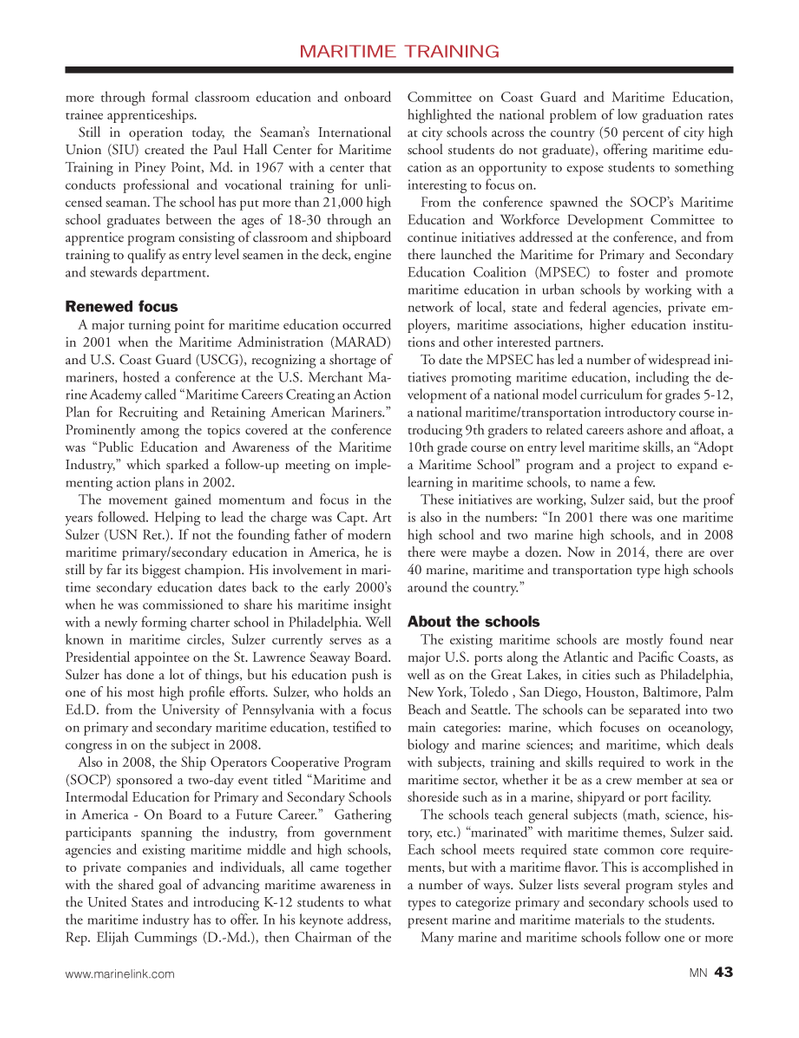
Page 43: of Marine News Magazine (June 2014)
Dredging & Marine Construction
Read this page in Pdf, Flash or Html5 edition of June 2014 Marine News Magazine
MARITIME TRAININGmore through formal classroom education and onboard trainee apprenticeships. Still in operation today, the Seaman?s International Union (SIU) created the Paul Hall Center for Maritime Training in Piney Point, Md. in 1967 with a center that conducts professional and vocational training for unli- censed seaman. The school has put more than 21,000 high school graduates between the ages of 18-30 through an apprentice program consisting of classroom and shipboard training to qualify as entry level seamen in the deck, engine and stewards department. Renewed focusA major turning point for maritime education occurred in 2001 when the Maritime Administration (MARAD) and U.S. Coast Guard (USCG), recognizing a shortage of mariners, hosted a conference at the U.S. Merchant Ma- rine Academy called ?Maritime Careers Creating an Action Plan for Recruiting and Retaining American Mariners.? Prominently among the topics covered at the conference was ?Public Education and Awareness of the Maritime Industry,? which sparked a follow-up meeting on imple- menting action plans in 2002.The movement gained momentum and focus in the years followed. Helping to lead the charge was Capt. Art Sulzer (USN Ret.). If not the founding father of modern maritime primary/secondary education in America, he is still by far its biggest champion. His involvement in mari- time secondary education dates back to the early 2000?s when he was commissioned to share his maritime insight with a newly forming charter school in Philadelphia. Well known in maritime circles, Sulzer currently serves as a Presidential appointee on the St. Lawrence Seaway Board. Sulzer has done a lot of things, but his education push is one of his most high pro le efforts. Sulzer, who holds an Ed.D. from the University of Pennsylvania with a focus on primary and secondary maritime education, testi ed to congress in on the subject in 2008. Also in 2008, the Ship Operators Cooperative Program (SOCP) sponsored a two-day event titled ?Maritime and Intermodal Education for Primary and Secondary Schools in America - On Board to a Future Career.? Gathering participants spanning the industry, from government agencies and existing maritime middle and high schools, to private companies and individuals, all came together with the shared goal of advancing maritime awareness in the United States and introducing K-12 students to what the maritime industry has to offer. In his keynote address, Rep. Elijah Cummings (D.-Md.), then Chairman of the Committee on Coast Guard and Maritime Education, highlighted the national problem of low graduation rates at city schools across the country (50 percent of city high school students do not graduate), offering maritime edu-cation as an opportunity to expose students to something interesting to focus on. From the conference spawned the SOCP?s Maritime Education and Workforce Development Committee to continue initiatives addressed at the conference, and from there launched the Maritime for Primary and Secondary Education Coalition (MPSEC) to foster and promote maritime education in urban schools by working with a network of local, state and federal agencies, private em- ployers, maritime associations, higher education institu- tions and other interested partners. To date the MPSEC has led a number of widespread ini- tiatives promoting maritime education, including the de- velopment of a national model curriculum for grades 5-12, a national maritime/transportation introductory course in- troducing 9th graders to related careers ashore and a oat, a 10th grade course on entry level maritime skills, an ?Adopt a Maritime School? program and a project to expand e- learning in maritime schools, to name a few. These initiatives are working, Sulzer said, but the proof is also in the numbers: ?In 2001 there was one maritime high school and two marine high schools, and in 2008 there were maybe a dozen. Now in 2014, there are over 40 marine, maritime and transportation type high schools around the country.? About the schoolsThe existing maritime schools are mostly found near major U.S. ports along the Atlantic and Paci c Coasts, as well as on the Great Lakes, in cities such as Philadelphia, New York, Toledo , San Diego, Houston, Baltimore, Palm Beach and Seattle. The schools can be separated into two main categories: marine, which focuses on oceanology, biology and marine sciences; and maritime, which deals with subjects, training and skills required to work in the maritime sector, whether it be as a crew member at sea or shoreside such as in a marine, shipyard or port facility. The schools teach general subjects (math, science, his-tory, etc.) ?marinated? with maritime themes, Sulzer said. Each school meets required state common core require- ments, but with a maritime avor. This is accomplished in a number of ways. Sulzer lists several program styles and types to categorize primary and secondary schools used to present marine and maritime materials to the students. Many marine and maritime schools follow one or more www.marinelink.com MN 43MN June14 Layout 32-49.indd 43MN June14 Layout 32-49.indd 435/20/2014 10:24:10 AM5/20/2014 10:24:10 AM

 42
42

 44
44
